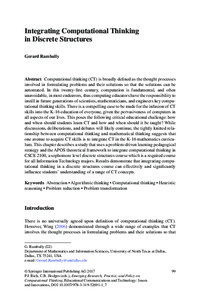Integrating Computational Thinking in Discrete StructuresGerard Rambally
Zu finden in: Emerging Research, Practice, and Policy on Computational Thinking (Seite 99 bis 119), 2017
  |
 |
 Diese Seite wurde seit 8 Jahren inhaltlich nicht mehr aktualisiert.
Unter Umständen ist sie nicht mehr aktuell.
Diese Seite wurde seit 8 Jahren inhaltlich nicht mehr aktualisiert.
Unter Umständen ist sie nicht mehr aktuell.
 Zusammenfassungen
Zusammenfassungen

Computational thinking (CT) is broadly defined as the thought processes involved in formulating problems and their solutions so that the solutions can be automated. In this twenty-first century, computation is fundamental, and often unavoidable, in most endeavors, thus computing educators have the responsibility to instill in future generations of scientists, mathematicians, and engineers key computational thinking skills. There is a compelling case to be made for the infusion of CT skills into the K-16 education of everyone, given the pervasiveness of computers in all aspects of our lives. This poses the following critical educational challenge: how and when should students learn CT and how and when should it be taught? While discussions, deliberations, and debates will likely continue, the tightly knitted relationship between computational thinking and mathematical thinking suggests that one avenue to acquire CT skills is to integrate CT in the K-16 mathematics curriculum. This chapter describes a study that uses a problem-driven learning pedagogical strategy and the APOS theoretical framework to integrate computational thinking in CSCE 2100, a sophomore level discrete structures course which is a required course for all Information Technology majors. Results demonstrate that integrating computational thinking in a discrete structures course can effectively and significantly influence students´ understanding of a range of CT concepts.
 Dieses Kapitel erwähnt ...
Dieses Kapitel erwähnt ...
 Personen KB IB clear | George H. L. Fletcher , James J. Lu , Jeannette M. Wing | |||||||||||||||||||||||||||
 Begriffe KB IB clear | computational thinkingcomputational thinking | |||||||||||||||||||||||||||
 Texte |
|
 Zitationsgraph
Zitationsgraph
 Zitationsgraph (Beta-Test mit vis.js)
Zitationsgraph (Beta-Test mit vis.js)
 Anderswo finden
Anderswo finden
 Volltext dieses Dokuments
Volltext dieses Dokuments
 |  Integrating Computational Thinking in Discrete Structures: Artikel als Volltext bei Springerlink ( Integrating Computational Thinking in Discrete Structures: Artikel als Volltext bei Springerlink ( : :  , 353 kByte; , 353 kByte;  : :  ) ) |
 Anderswo suchen
Anderswo suchen 
 Beat und dieses Kapitel
Beat und dieses Kapitel
Beat hat Dieses Kapitel während seiner Zeit am Institut für Medien und Schule (IMS) ins Biblionetz aufgenommen. Er hat Dieses Kapitel einmalig erfasst und bisher nicht mehr bearbeitet. Beat besitzt kein physisches, aber ein digitales Exemplar. Eine digitale Version ist auf dem Internet verfügbar (s.o.). Aufgrund der wenigen Einträge im Biblionetz scheint er es nicht wirklich gelesen zu haben. Es gibt bisher auch nur wenige Objekte im Biblionetz, die dieses Werk zitieren.











 Biblionetz-History
Biblionetz-History